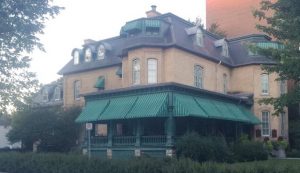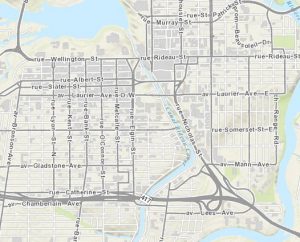la version française
A SANDY HILL STATEMENT
This is a document intended to provide detailed background and content that can be used as a source for letters, advertising, and debate to make the case for supporting Sandy Hill’s efforts to turn around the sad direction current development is leading us.

Sandy Hill is one of Canada’s oldest neighbourhoods, full of spectacular mansions, grand dame apartment buildings, pre-Confederation family homes and charming Victorian rowhouses. Its built heritage, valued for its unique diversity, reflects an unparalleled range of architectural styles, which span the mid 1800s to the 1950s. Over the course of more than 150 years, it has become one of the most historically-rich, nationally-important small-scale cultural landscapes in the country.
Home to figures such as Father of Medicare Tommy Douglas, ‘Poppy Lady’ Lillian Freiman, CPR magnate Sir Sandford Fleming, Olympic champion Barbara Ann Scott and WWI flying ace Billy Bishop, it has also served as residence to lumber barons, Governors General, Chief Justices of the Supreme Court, Cabinet Ministers, Mayors, Lieutenants Governor, Clerks of the Privy Council, and heads of national institutions. Perhaps even more incredibly, seven Fathers of Confederation and ten Prime Ministers have called Sandy Hill home, many of whose houses remain standing.
Today, when Canadians wander through Sandy Hill they are – quite literally – walking in the footsteps of our nation-builders.


Beginning in the 1960s and 70s, urban planning permitted the consolidation of lots and demolition of heritage buildings in favour of medium and high-rise buildings. These continue to serve as precedents for out-of-scale development, thus compounding the original problem. Moreover, in recent decades the rapid growth of the University of Ottawa has led to increased demand for high density student housing and has resulted in buildings called bunkhouses.
Bunkhouses are typically owned by absentee landlords, often resulting in properties poorly managed. Twenty or thirty people in one building create a lot more waste than a family of four on the same property. Proper garbage storage, excessive noise, and rowdyism have followed, becoming a major problem for all residents of Sandy Hill. This has added pressure without adding resources to Ottawa Bylaw Enforcement, whose officers struggle to enforce noise and Property Standard bylaws.
The erosion of neighbourhood character and beauty, the deterioration of heritage value, the loss of historic buildings, and a decline in the health of public spaces are the direct results of:
- the failure of the city to recognize and protect buildings Sandy Hillers regard as our built heritage, which includes early to mid-20th century buildings;
- low-quality development,
- short-sighted intensification practices,
- under-resourced bylaw and property standards enforcement and,
- policies and practices that effectively exempt absentee landlords from property maintenance and management obligations. They manage to get away with poor property management for years and pay small fines when actually ticketed.
The character of once beautiful streetscapes and historic avenues such as Laurier Ave and Chapel St., has been compromised by thoughtless modification, demolition, and incompatible infill. The loss of awareness of the historical significance and value of the neighbourhood has left the entire area more vulnerable to decay. Demolition by neglect continues unabated. Many properties are unkempt and abandoned. Illegal front yard parking is ignored by the city. Garbage litters many lawns and streets. Our greenspace is under threat.
Census data shows a population decline of 3.5% in our neighbourhood from 2011 to 2016. Anecdotal evidence indicates that many of these are long term residents Moreover, Sandy Hill is failing to provide for and attract the diverse range of residents needed to ensure its sustainability. The community fabric that holds Sandy Hill together is unravelling. Sandy Hill is becoming less attractive, less healthy, less diverse, less vital, and less livable. Sandy Hill is a neighbourhood in trouble.


So why should you care? Central Ottawa neighbourhoods comprise a network through which flow people, goods, and services on a daily basis. This urban core provides a substantial part of the overall economic, environmental and physical wellbeing of the National Capital Region as a whole. There would be no Ottawa without urban Ottawa. Historic Sandy Hill is an integral part of this network; its economic health and vitality matter not only to the thousands of people who live here, but also to the thousands more who come to and move through the area every day.
Safe, vibrant and attractive communities invite people in, encourage them to stay, and make them feel good while they’re there. In this way, high quality parks and public spaces, clean streets and beautiful architecture help create important economic, social, cultural and environmental value that spills beyond the boundaries of a given place. This in turn supports local businesses, decreases reliance on the car, improves public health, increases property values and generates greater revenue for the entire City.
A declining Sandy Hill serves only non-resident property owners, and predatory developers and investors. while at the same time costing Ottawans in terms of lost potential and lost opportunity. If current trends continue, fewer people will want to live here, housing prices will stagnate or drop resulting in decreased City revenues, shoddy development will replace nationally-important history and built heritage, crime will increase, and disproportionate burdens will be placed on other Wards.
Conversely, a thriving Sandy Hill benefits not just Sandy Hillers but Ottawa as a whole. Improved health, greater environmental sustainability, a higher quality of life, more tourism opportunities, and ongoing economic growth are just a few of those benefits.
Which do you choose?


What Do We Want:
- Recognition of and respect for Sandy Hill’s diverse history, which is embedded in its cultural landscape and built environment.
- Sustainability for Sandy Hill’s built heritage including its early-to-mid-20th century housing stock.
- Protection of properties that residents of Sandy Hill view as our heritage and our history.
- Support for the restoration and sensitive rehabilitation of community-targeted heritage.
- Well maintained and protected green streetscapes, Sandy Hill’s tree canopy and public spaces.
- Increased resources to preserve historic buildings.
- Attractive, appropriate, high-quality development that contributes to the character and vitality of the neighbourhood.
- A diversity of housing options to sustain a healthy balance of long- and short-term residents.
- A multiplicity of high-quality retail and commercial options, services and amenities.
How We Get There:
Planning, Heritage, and Enforcement
Planning
- Introduce amendments to the current Residential zone 4 (“R4”) through Phase II that prohibit the proliferation of bunkhouses, respect the neighbourhood character, and bring back the ‘missing middle’.
- Implement full Site Plan Control for all new development.
- Initiate and obtain city support for a citizen-led process to amend the Sandy Hill Secondary Plan to include:
- Sandy Hill-specific design standards.
- Targeted intensification zones so that we get the amenities and managed growth we need.
- Stabilization zones that have the effect of down-zoning.
- A sustainable and livable housing strategy, including student housing.
- Continue to advocate for a rental registry.
- Create tax incentives and disincentives to both stimulate positive development, particularly community-supported projects, and deter negative development practices.
- Renew public space infrastructure (better street furniture, city maintenance of our neighbourhood ice skating rink, etc.).
- Lobby the city to plant more trees on street rights-of-way.
Heritage
- Implement new heritage designations, particularly targeting streets south of Osgoode.
- Promote and support preservation and sensitive rehabilitation of heritage properties instead of demolition and replacement.
- Create significant incentives, tools, and resources to assist homeowners with the preservation and restoration of historic properties.
- Bring an end to demolition-by-neglect, if need be expropriating heritage properties before it’s too late to save them.
Enforcement
- Obtain adequate resources for the pro-active enforcement of bylaw and property standards, including strong deterrent measures.
- Implement a Rental property licensing system.
- Implement a city-wide strategy for addressing delinquent landlords.

The Missing Middle – the kind of not-single-family, not-condo-tower-apartment style of housing that provides enough room for a couple of parents and kids, has some kind of ground-level space outside and doesn’t cost a fortune.

How Can You Contribute?
The Changes we wish to see require citizen engagement:
- Participate in the upcoming Phase 2 of the R4 Study.
- Join thousands of fellow citizens who have already signed the Saving Sandy Hill petition (https://www.change.org/p/save-sandy-hill-sauver-c%C3%B4te-de-sable).
- Send a letter to the Mayor and our Councillors (customizable form letters provided).
- Make this an election issue! Attend all-candidates debates and ask about this issue.
- Help us ditch the NIMBY (Not-In-My-BackYard) and embrace the BIMBY (Beauty-In-My-Back-Yard).
Sandy Hillers of all walks of life, of all ages and of all backgrounds want the same thing: a healthy, prosperous, attractive, viable, equitable, walkable, intergenerational, green neighbourhood. Achieving this requires political will, bureaucratic support and citizen engagement.
